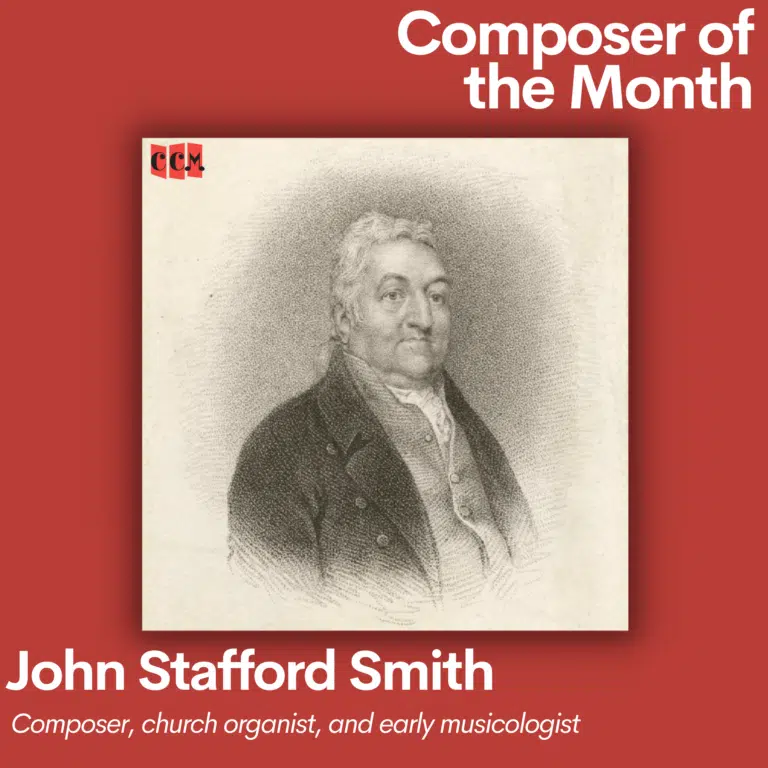June 21, 2023
John Stafford Smith: July Composer of the Month

This July, we are highlighting the brilliant composer John Stafford Smith, renowned for his iconic composition, “The Star-Spangled Banner.” Read on as we delve into Smith’s life, explore the captivating story behind his masterpiece, and gain insights into the significance of national anthems in the world of music.
John Stafford Smith: A Brief History
John Stafford Smith was born in 1750 in Gloucester, England. From a young age, he showcased remarkable musical talent. He received comprehensive musical education and training as he studied under esteemed composers of his time. Smith’s career blossomed in London, where he emerged as a prominent musical figure in the late 18th-century. Smith created symphonies, chamber music, and choral compositions that all showcased his immense talent.The Story Behind “The Star-Spangled Banner”
“The Star-Spangled Banner” originated during the War of 1812, a conflict between the United States and the British Empire. In September 1814, poet, Francis Scott Key witnessed the British bombardment of Fort McHenry in Baltimore Harbor. He was then inspired to write a poem titled “Defence of Fort M’Henry.” Key was seeking a fitting melody for his powerful verses and turned to his friend, John Stafford Smith. Smith’s composition, “To Anacreon in Heaven,” originally written for a British men’s social club, proved to be the perfect match for Key’s patriotic lyrics. Together, they transformed the melody into what would become one of the world’s most recognizable national anthems. In 1931, “The Star-Spangled Banner” officially became the national anthem of the United States, symbolizing the nation’s unity, resilience, and indomitable spirit.National Anthems: A Brief History
National anthems hold great cultural and historical significance, offering valuable insights into a country’s identity and heritage. They serve as musical symbols of national unity, resilience, and pride. Here are a few reasons why national anthems are worth exploring:Historical Context
National anthems provide a window into a nation’s past, reflecting its struggles, triumphs, and collective memory. They embody historical events and moments of national significance, offering a deeper understanding of a country’s heritage. National anthems are sonic narratives that connect present generations to the triumphs and challenges faced by their predecessors, fostering a sense of continuity and national pride. Through the evocative power of music, national anthems become a living testament to a nation’s history, allowing us to experience the emotions and aspirations that have shaped past generations.Musical Analysis
Exploring national anthems allows us to appreciate the melodic and harmonic elements that define them. By examining their structure, tonality, and musical motifs, we gain insights into the compositional techniques employed by different composers and the cultural influences that shaped their creations. You can learn a lot about a country’s music history from their national anthem!Cultural Identity
National anthems are rich expressions of a country’s cultural identity, encompassing its traditions, values, and aspirations. By studying anthems from various nations, we can embrace the diversity of global musical heritage and foster intercultural understanding. The origin of national anthems also vary, and can provide even more information about the nation’s culture and history.Emotional Connection & Evolution
National anthems evoke a sense of pride, unity, and patriotism among citizens. By engaging with these powerful musical compositions, we can experience the emotional resonance they hold for individuals and communities. National anthems can also evoke important conversations regarding a nation’s successes and failures. The anthems can also inspire other songs and art pieces that speak to lived experiences. John Stafford Smith’s composition of “The Star-Spangled Banner” represents a pivotal moment in musical history. Through its triumphant melody and patriotic lyrics, it encapsulates the enduring spirit of a nation. National anthems, like “The Star-Spangled Banner,” are musical artifacts provide us with valuable insights into the cultural, historical, and emotional dimensions of countries around the world. Let us continue to celebrate and appreciate the composers who have left their indelible mark on our musical landscape, reminding us of the profound power that music holds in shaping our collective identity.
